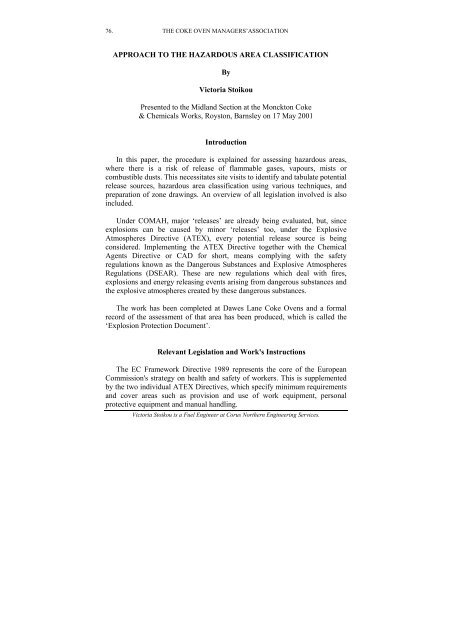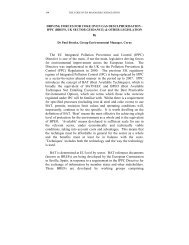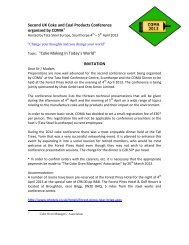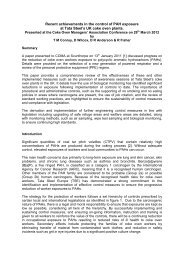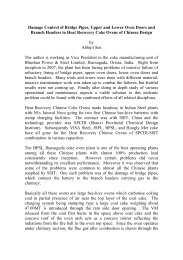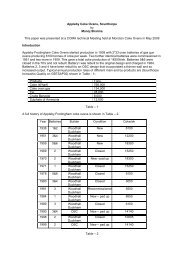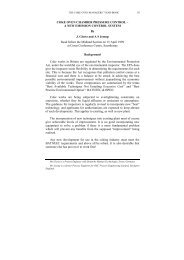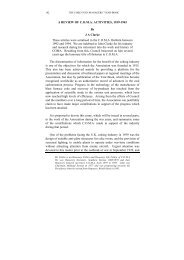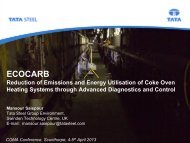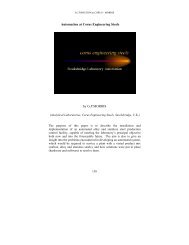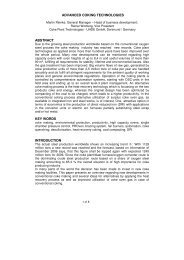CHAIRMAN'S ADDRESS - Coke Oven Managers Association
CHAIRMAN'S ADDRESS - Coke Oven Managers Association
CHAIRMAN'S ADDRESS - Coke Oven Managers Association
Create successful ePaper yourself
Turn your PDF publications into a flip-book with our unique Google optimized e-Paper software.
76. THE COKE OVEN MANAGERS’ASSOCIATIONAPPROACH TO THE HAZARDOUS AREA CLASSIFICATIONByVictoria StoikouPresented to the Midland Section at the Monckton <strong>Coke</strong>& Chemicals Works, Royston, Barnsley on 17 May 2001IntroductionIn this paper, the procedure is explained for assessing hazardous areas,where there is a risk of release of flammable gases, vapours, mists orcombustible dusts. This necessitates site visits to identify and tabulate potentialrelease sources, hazardous area classification using various techniques, andpreparation of zone drawings. An overview of all legislation involved is alsoincluded.Under COMAH, major ‘releases’ are already being evaluated, but, sinceexplosions can be caused by minor ‘releases’ too, under the ExplosiveAtmospheres Directive (ATEX), every potential release source is beingconsidered. Implementing the ATEX Directive together with the ChemicalAgents Directive or CAD for short, means complying with the safetyregulations known as the Dangerous Substances and Explosive AtmospheresRegulations (DSEAR). These are new regulations which deal with fires,explosions and energy releasing events arising from dangerous substances andthe explosive atmospheres created by these dangerous substances.The work has been completed at Dawes Lane <strong>Coke</strong> <strong>Oven</strong>s and a formalrecord of the assessment of that area has been produced, which is called the‘Explosion Protection Document’.Relevant Legislation and Work's InstructionsThe EC Framework Directive 1989 represents the core of the EuropeanCommission's strategy on health and safety of workers. This is supplementedby the two individual ATEX Directives, which specify minimum requirementsand cover areas such as provision and use of work equipment, personalprotective equipment and manual handling.Victoria Stoikou is a Fuel Engineer at Corus Northern Engineering Services.
APPROACH TO THE HAZARDOUS AREA 77CLASSIFICATION - STOIKOUThe first (Article 95 Directive 94/9/EC) sets out to facilitate the freemovement of goods throughout the EU by harmonising the technical and legalrequirements for products intended for use in potentially explosiveatmospheres. It was implemented in the UK by Statutory Instrument No 192,viz: " The Equipment and Protective Systems Regulations Intended for Use inPotentially Hazardous Atmospheres Regulations 1996". This directive cameinto force 1 March 1996 with a 7-year transition period, and will be fullyeffective on the 30 June 2003.The second (Article 137 Directive 99/92/EC) adopts further measuresaimed at protecting workers potentially at risk from explosive atmospheres andduties are placed on the employer. It was adopted on the 16 December, 1999,with a formal date for implementation by the Member States of the 30 June2003, and requires employers to:• prevent and provide protection against explosions• assess explosion risks and draw up an explosion protectiondocument• implement measures to ensure work in explosive atmospherescan be carried out safely• co-ordinate the implementation of health and safety measureswith other employers• classify, zone and mark areas where explosive atmospheresmay occurThe Chemical Agents Directive (CAD) (Directive 98/24/EC) sets out whatemployers should do as a minimum to protect their workers from the effects of"hazardous chemical agents". Any substance (solid, liquid, gas, vapour or dust)that could be hazardous to health or safety because of the way it is used orpresent at work is covered by this Directive. This includes substances that areharmful because they have an intrinsic property which is explosive,flammable, oxidising, toxic, harmful, corrosive, irritant, or because they areharmful as a result of the way they are used at work (e.g. heated).It should have been implemented on 5 May, 2001, however, the HSESafety Policy Directorate decided that because that part of CAD relating toexplosive hazards of chemicals, viz the 'safety' part, overlapped with ATEX,both should be combined to form new regulations. It was also decided toreview existing regulations relating to flammable and explosive substances,
78 THE COKE OVEN MANAGERS’ASSOCIATIONwhich should be subsumed in the work to implement the Directive. One of thebest known of these being 'The Highly Flammable Liquids and LiquefiedPetroleum Gases Regulations, 1972'. The new regulations will be known as'The Dangerous Substances and Explosive Atmospheres Regulations 2001'(DSEAR).DSEAR is intended to protect not only employees at the workplace, butalso any other person whether at work or not who may be put at risk bydangerous substances. This includes employees working for other employers,visitors to the site, members of the public, etc.A new Business Health & Safety Instruction No. 6 "Area Classification,Installation, Operation and Maintenance of Equipment for PotentiallyExplosive Atmospheres" was issued in December, 2000, to supersedeW. I. (Engineering) No.18, and take account of the ATEX Directives.Compliance with this new instruction will ensure our present and future legalobligations under DSEAR are met.Sources of Release Data SheetsTable 1 gives an example of a Hazardous Area Data Sheet which includessome of the numerous sources of release at the by-products plant at DawesLane <strong>Coke</strong> <strong>Oven</strong>s. The exercise for that area, which has been classified asZone 2 (column 9 – Table 1), was done last year and the exact date is given atthe top of the table. The first column gives a description of all possible sourcesof <strong>Coke</strong> <strong>Oven</strong> Gas release at that point of the plant and column No. 2, theiridentification located out on plant. In the third column of the table, the grade ofeach release is stated. In this case, the grade is 'Secondary', which applies whenflanges, connections/pipe fittings, sample points, (relief) valves and vents arenot expected to release flammable material in the atmosphere under normaloperation. Other classifications of the grade of release, are 'Continuous' and'Primary' for cases when the surface of the flammable material is open to theatmosphere continuously or for long periods respectively; the release isexpected to occur again during normal operation. Column No. 4 of the tablegives a number referring to the type of material involved and No. 7 gives itsstate; as already mentioned, all examples presented in this report involve <strong>Coke</strong><strong>Oven</strong> Gas.
APPROACH TO THE HAZARDOUS AREA 79CLASSIFICATION - STOIKOU
80 THE COKE OVEN MANAGERS’ASSOCIATIONThe operating conditions, specifically the Pressure and Temperature of thegas at each point, are given at columns 5 & 6. Column No. 8 is aboutventilation at that part of the plant. Ventilation can either be Artificial meaningmovement of air with fans, or Natural when movement of air is due to thewind or/and by temperature gradients. Table 1 includes outdoor releases only,hence, ventilation is of Natural type.Medium degree of ventilation is the appropriate category for Zone 2 areasand means that the concentration involved can be controlled and beyond thezone boundary is below the Lower Explosive Limit. The term 'LowVentilation' is used when the concentration cannot be controlled whilst arelease is in progress and/or undue persistence of a flammable atmosphereafter the release has stopped cannot be prevented. The availability in Zone 2areas is 'Fair' which means that ventilation is present during normal operationand infrequent discontinuities are permitted for short periods.The zone extent given in metres in columns No. 10 and 11, is the horizontaland vertical distance calculated using dispersion modelling for flammable gasreleases with a software package called PHAST Professional Version 6.0. Afurther explanation of this work is given later in this report. Finally, columnNo. 13, includes the actual height of the potential gas release in metres and theletter C means that the source of the release is between bolts.A schematic approach to the classification of hazardous areas is alsoprepared. This includes similar information as the Source of Release DataSheets using an easy to follow diagram.Classification of Potentially Hazardous AreasArea classification is a method of analysing and classifying theenvironment where explosive atmospheres may occur taking into account gasgroupings and temperature classifications. Dawes Lane <strong>Coke</strong> <strong>Oven</strong>s have beenclassified as a Zone 2 area in the whole, except of the underfiring part of theBatteries, the Benzole Loading area and the Exhauster House which areZone 1, meaning that an explosive gas atmosphere is likely to occur in normaloperation.In Zone 2 areas, an explosive gas atmosphere is not likely to occur innormal operation and if it does occur is likely to do so only infrequently andwill exist for a short period only. On the other hand, Zone 0 areas are thosewhere an explosive gas atmosphere is present continuously or for long periods.
APPROACH TO THE HAZARDOUS AREA 81CLASSIFICATION - STOIKOUThe equivalent dust Zones are 20, 21 and 22. Fig. 1 shows the symbols for allgas zone types.Fig 1Gas Zone TypesComputer ModelingThe Process Hazard Analysis Software Tool (PHAST Prof. Version 6.0) isused for the calculation of the zonal extent of a hazardous area. It uses built-inchemical and parameter data, along with scenario and meteorological datasupplied by the user to predict the flammable effects from atmospheric releasesof hazardous materials.The first stage in PHAST's calculations is the discharge model whichpredicts the flow rate and state of the material as it is released into theatmosphere. The results from the discharge calculations are then used byPHAST, along with the meteorological information, in the dispersion model.The dispersing cloud can follow a range of paths, all of which are modelled byPHAST as well as all possible flammable outcomes.A side view example of a dispersion cloud displayed dynamically is shownin Fig. 2. This case is time dependent and represents a <strong>Coke</strong> <strong>Oven</strong> Gas,outdoor, horizontal release from a valve flange. The scenario type is a 'leak',with a hole diameter of 9.4mm, at 10 metres height above ground level. Threedifferent concentration levels are shown in Fig. 2; the one of most interest isthe same value as the Lower Explosive Limit of the gas, which is 4.45% vol.
82 THE COKE OVEN MANAGERS’ASSOCIATIONAll weather inputs (wind speed, stability class, atmosphere and surfacetemperature, surface roughness, and humidity) can be varied. However, thestability class and wind speeds are linked. The weather category chosen forPHAST calculations at Dawes Lane <strong>Coke</strong> <strong>Oven</strong>s is 1.5D which stands for awindy day with little sun (wind speed: 1.5m/s) or overcast/windy night. Theimported process conditions in the example at Fig. 1, are 30C and a pressure of56mbar.Fig. 2PHAST ModelThe base averaging time used in PHAST for all the cases considered is thatfor Flammables (=18.75 sec). Averaging time comes into effect when thecloud becomes passive. When the cloud is active, the concentration profile willbe constant. When the cloud becomes passive, the wind will cause the cloud tomeander. If there is a monitor where the cloud is passive, sometimes it mightmeasure the edge of the cloud. Other times it might be measuring the centre or
APPROACH TO THE HAZARDOUS AREA 83CLASSIFICATION - STOIKOUnothing at all, as the cloud is moving past that point. Therefore, an averagingtime is used to find the concentration at that point.Finally, the downwind distance on x-axis of the dispersion graph calculatedby PHAST, is an essential factor for the determination of the zonal extent. Thevertical and horizontal 'cloud' distance reached from every possible source ofrelease is noted down in the Hazardous Area Data Sheets (Table 1).Zone Boundary Marking and DrawingsLegislation requires that areas where explosive atmospheres may occur areclassified, zoned and marked. It is therefore necessary for all areas classified ashazardous to be marked with the sign shown in Fig. 3.Also, a major role in the approach to classification of hazardous areas playsthe preparation of zone drawings.Fig. 3Place where explosive atmospheres may occurConclusion
84 THE COKE OVEN MANAGERS’ASSOCIATIONNow that the Dawes Lane <strong>Coke</strong> <strong>Oven</strong>s area has been assessed and certainrequirements established, departmental managers need to ensure that allelectrical and mechanical equipment within their identified hazardous areas areof a suitable category and arrange replacements where necessary. Although thecompliance date of 30 June 2003 is for all new equipment commissioned orinstalled after that date, it would be wise to ensure any replacement equipmentinstalled before then meets the new standards.As well as the necessity to ensure equipment in the zoned areas complieswith present and imminent regulations, there is a duty to ensure that access andworking procedures in these areas are prepared, and ongoing maintenance iscarried out to the required standard.Finally, the ATEX Directive makes it a legal requirement that the'Explosion Protection Document', produced to include all details of theapproach to the hazardous area classification, is updated annually.


